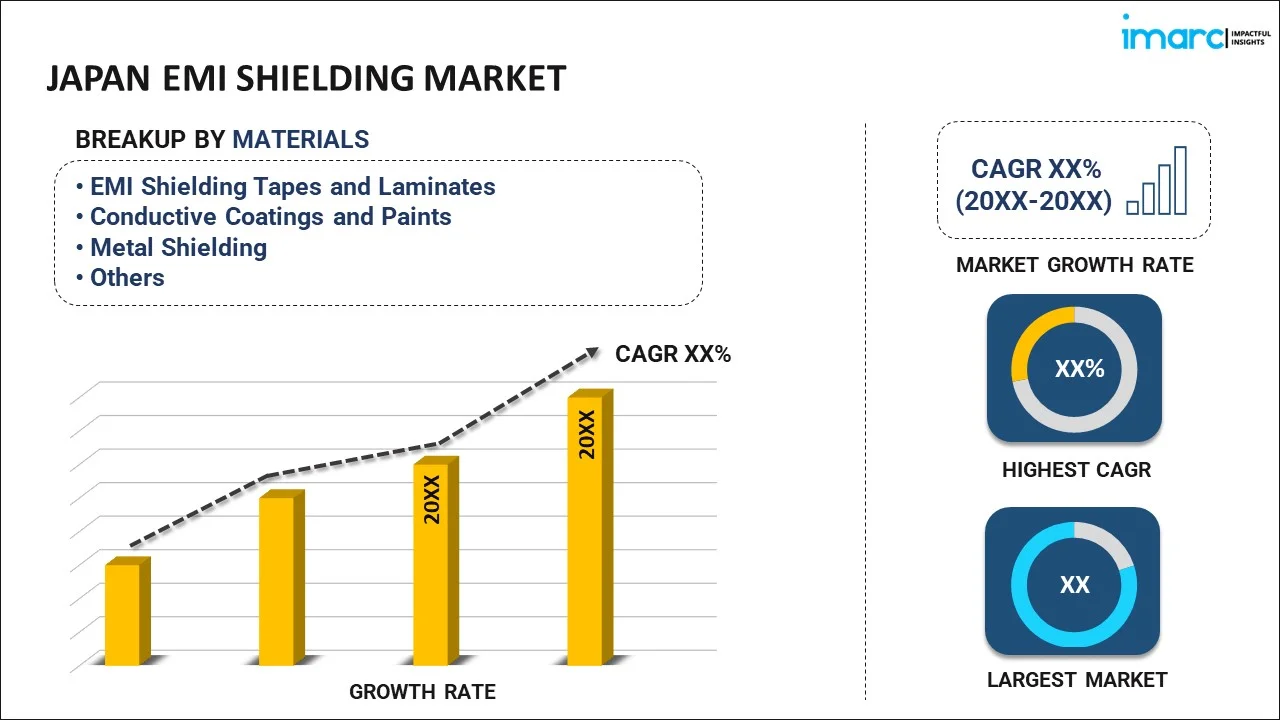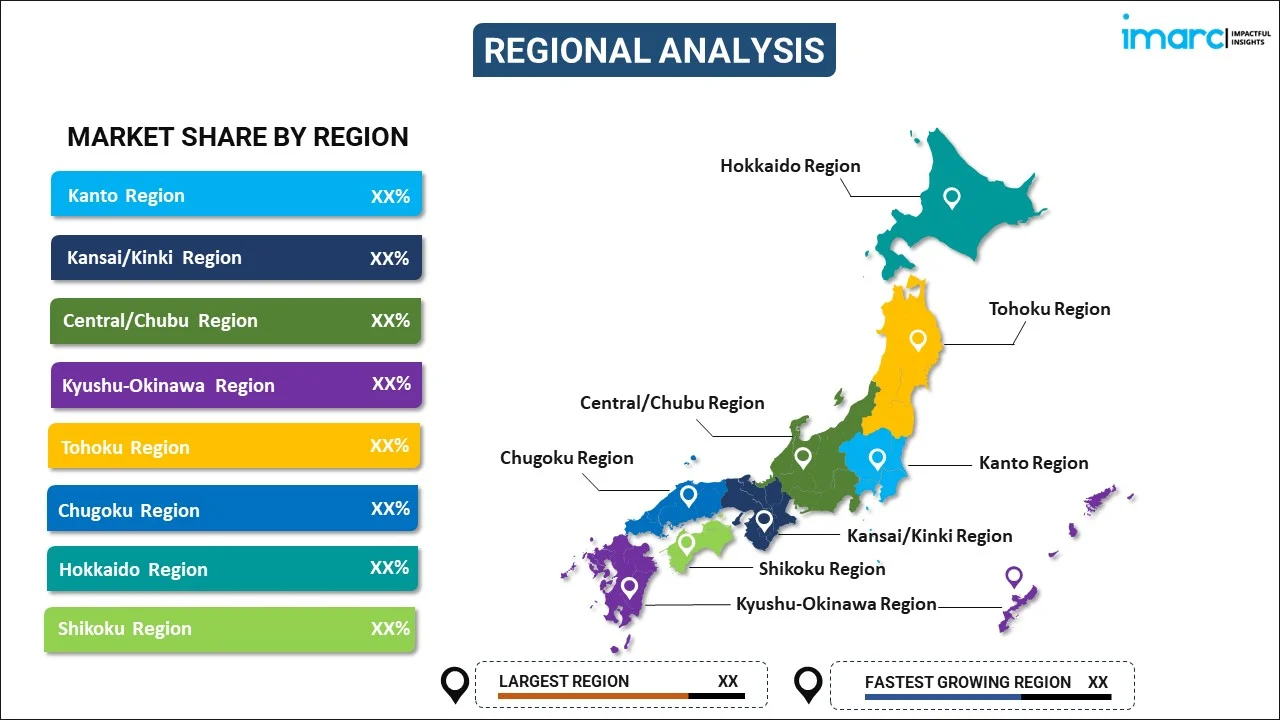
Japan EMI Shielding Market Report by Material (EMI Shielding Tapes and Laminates, Conductive Coatings and Paints, Metal Shielding, Conductive Polymers, EMI/EMC Filters, and Others), Shielding Method (Radiation, Conduction), End Use Industry (Consumer Electronics, Telecom and IT, Automotive, Healthcare, Defense and Aerospace and Others), and Region 2025-2033
Market Overview:
Japan EMI shielding market size reached USD 451.0 Million in 2024. Looking forward, IMARC Group expects the market to reach USD 694.0 Million by 2033, exhibiting a growth rate (CAGR) of 4.92% during 2025-2033. The increasing application of electronic devices, including smartphones, tablets, IoT devices and electric vehicles, along with the growing need for EMI shielding to prevent electromagnetic interference that can disrupt their operation, is driving the market.
|
Report Attribute
|
Key Statistics
|
|---|---|
|
Base Year
|
2024
|
|
Forecast Years
|
2025-2033
|
|
Historical Years
|
2019-2024
|
| Market Size in 2024 | USD 451.0 Million |
| Market Forecast in 2033 | USD 694.0 Million |
| Market Growth Rate 2025-2033 | 4.92% |
EMI (electromagnetic interference) shielding is a protective technique used in various electronic and electrical devices to prevent unwanted electromagnetic radiation from interfering with their proper functioning or to prevent them from emitting harmful radiation that could interfere with nearby equipment. EMI shielding typically involves using materials with high electrical conductivity, such as metals like aluminum or copper, to create barriers or enclosures around sensitive components. These materials are chosen because they can effectively absorb or reflect electromagnetic waves, thereby reducing or blocking the transmission of EMI. Common EMI shielding methods include metal enclosures, conductive coatings, and shielding gaskets. These components are strategically placed in devices like smartphones, computers, and medical equipment to ensure they meet regulatory requirements and maintain their electromagnetic compatibility (EMC). EMI shielding is crucial in modern technology to prevent signal degradation, data loss, or malfunctions caused by electromagnetic interference, ensuring the reliable operation of electronic systems and the safety of users.
Japan EMI Shielding Market Trends:
The EMI shielding market in Japan is experiencing robust growth, primarily driven by several key factors. Firstly, the rapid proliferation of electronic devices in various industries is a pivotal driver. With the increasing reliance on smartphones, IoT devices, and wireless communication technologies, the demand for effective EMI shielding solutions has surged. Furthermore, the rising trend of miniaturization in electronics has propelled the market forward. As electronic components become smaller and more densely packed, the susceptibility to EMI interference has heightened, necessitating advanced shielding materials and techniques. In addition to this, stringent regulations and standards governing EMI emissions have created a strong impetus for EMI shielding solutions. Compliance with these regulations is essential for manufacturers to ensure product safety and reliability, further fueling the demand for EMI shielding materials and solutions. Moreover, the automotive industry's shift towards electric and hybrid vehicles, which require effective EMI shielding to prevent interference with sensitive electronic systems, is expected to drive the market in Japan during the forecast period.
Japan EMI Shielding Market Segmentation:
IMARC Group provides an analysis of the key trends in each segment of the market, along with forecasts at the country level for 2025-2033. Our report has categorized the market based on material, shielding method, and end use industry.
Material Insights:

- EMI Shielding Tapes and Laminates
- Conductive Coatings and Paints
- Metal Shielding
- Conductive Polymers
- EMI/EMC Filters
- Others
The report has provided a detailed breakup and analysis of the market based on the material. This includes EMI shielding tapes and laminates, conductive coatings and paints, metal shielding, conductive polymers, EMI/EMC filters, and others.
Shielding Method Insights:
- Radiation
- Conduction
A detailed breakup and analysis of the market based on the shielding method have also been provided in the report. This includes radiation and conduction.
End Use Industry Insights:
- Consumer Electronics
- Smartphones
- Tablets
- Television
- Others
- Telecom and IT
- Automotive
- Healthcare
- Defense and Aerospace
- Others
The report has provided a detailed breakup and analysis of the market based on the end use industry. This includes consumer electronics (smartphones, tablets, television, and others), telecom and IT, automotive, healthcare, defense and aerospace, and others.
Regional Insights:

- Kanto Region
- Kansai/Kinki Region
- Central/ Chubu Region
- Kyushu-Okinawa Region
- Tohoku Region
- Chugoku Region
- Hokkaido Region
- Shikoku Region
The report has also provided a comprehensive analysis of all the major regional markets, which include Kanto Region, Kansai/Kinki Region, Central/ Chubu Region, Kyushu-Okinawa Region, Tohoku Region, Chugoku Region, Hokkaido Region, and Shikoku Region.
Competitive Landscape:
The market research report has also provided a comprehensive analysis of the competitive landscape. Competitive analysis such as market structure, key player positioning, top winning strategies, competitive dashboard, and company evaluation quadrant has been covered in the report. Also, detailed profiles of all major companies have been provided.
Japan EMI Shielding Market Report Coverage:
| Report Features | Details |
|---|---|
| Base Year of the Analysis | 2024 |
| Historical Period | 2019-2024 |
| Forecast Period | 2025-2033 |
| Units | Million USD |
| Scope of the Report | Exploration of Historical Trends and Market Outlook, Industry Catalysts and Challenges, Segment-Wise Historical and Future Market Assessment:
|
| Materials Covered | EMI Shielding Tapes and Laminates, Conductive Coatings and Paints, Metal Shielding, Conductive Polymers, EMI/EMC Filters, Others |
| Shielding Methods Covered | Radiation, Conduction |
| End Use Industries Covered |
|
| Regions Covered | Kanto Region, Kansai/Kinki Region, Central/ Chubu Region, Kyushu-Okinawa Region, Tohoku Region, Chugoku Region, Hokkaido Region, Shikoku Region |
| Customization Scope | 10% Free Customization |
| Post-Sale Analyst Support | 10-12 Weeks |
| Delivery Format | PDF and Excel through Email (We can also provide the editable version of the report in PPT/Word format on special request) |
Key Questions Answered in This Report:
- How has the Japan EMI shielding market performed so far and how will it perform in the coming years?
- What has been the impact of COVID-19 on the Japan EMI shielding market?
- What is the breakup of the Japan EMI shielding market on the basis of material?
- What is the breakup of the Japan EMI shielding market on the basis of shielding method?
- What is the breakup of the Japan EMI shielding market on the basis of end use industry?
- What are the various stages in the value chain of the Japan EMI shielding market?
- What are the key driving factors and challenges in the Japan EMI shielding?
- What is the structure of the Japan EMI shielding market and who are the key players?
- What is the degree of competition in the Japan EMI shielding market?
Key Benefits for Stakeholders:
- IMARC’s industry report offers a comprehensive quantitative analysis of various market segments, historical and current market trends, market forecasts, and dynamics of the Japan EMI shielding market from 2019-2033.
- The research report provides the latest information on the market drivers, challenges, and opportunities in the Japan EMI shielding market.
- Porter's five forces analysis assist stakeholders in assessing the impact of new entrants, competitive rivalry, supplier power, buyer power, and the threat of substitution. It helps stakeholders to analyze the level of competition within the Japan EMI shielding industry and its attractiveness.
- Competitive landscape allows stakeholders to understand their competitive environment and provides an insight into the current positions of key players in the market.
Need more help?
- Speak to our experienced analysts for insights on the current market scenarios.
- Include additional segments and countries to customize the report as per your requirement.
- Gain an unparalleled competitive advantage in your domain by understanding how to utilize the report and positively impacting your operations and revenue.
- For further assistance, please connect with our analysts.
 Inquire Before Buying
Inquire Before Buying
 Speak to an Analyst
Speak to an Analyst
 Request Brochure
Request Brochure
 Request Customization
Request Customization




.webp)




.webp)












